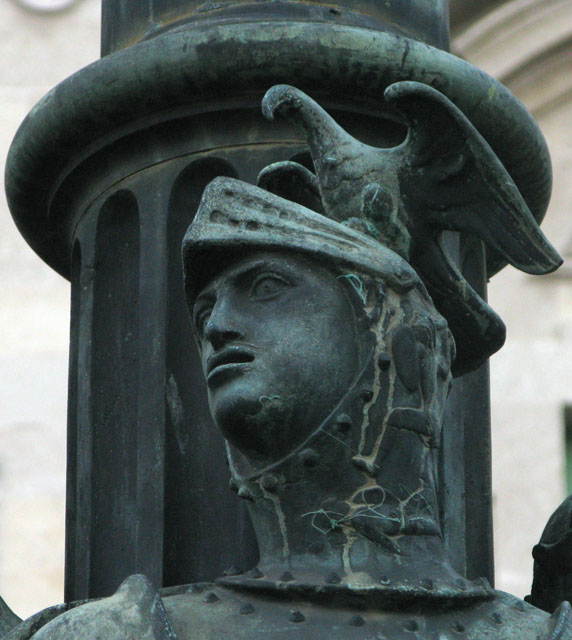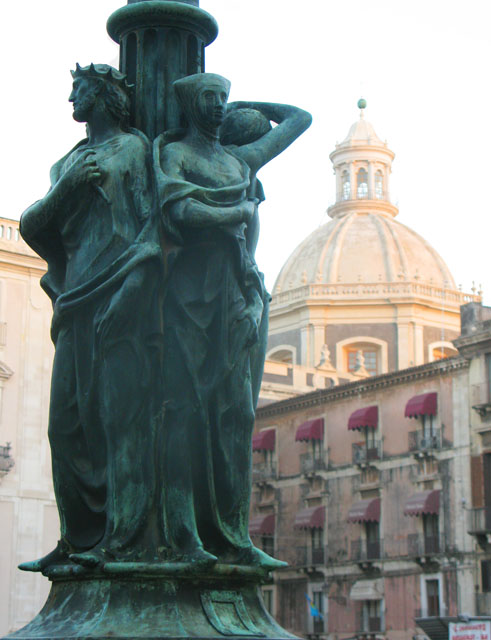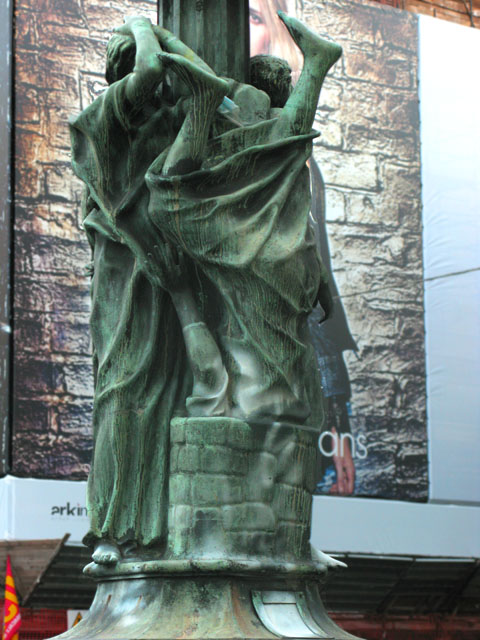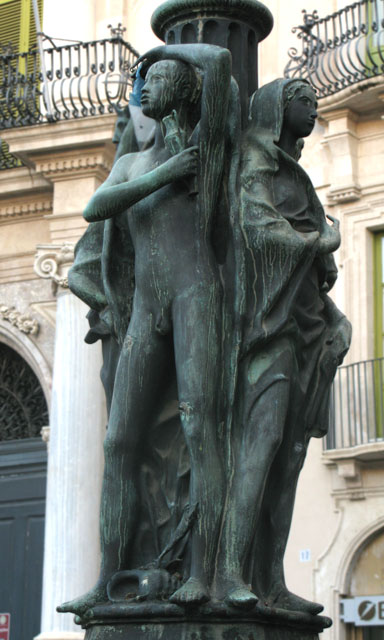 You know when you walk around a place so much that you don’t see it? Well, until recently that had been the case in Catania for me. I say ‘until recently’ because it all changed when I moved into my current flat. One of the wonderful things about living with a born and bred Catanese has been hearing the legends and history of the city: in the two months that I’ve been living in this flat I’ve learnt more about the city than I have in the previous 12 combined.
You know when you walk around a place so much that you don’t see it? Well, until recently that had been the case in Catania for me. I say ‘until recently’ because it all changed when I moved into my current flat. One of the wonderful things about living with a born and bred Catanese has been hearing the legends and history of the city: in the two months that I’ve been living in this flat I’ve learnt more about the city than I have in the previous 12 combined.
In Piazza Università, for instance, there are four lamp posts at the four corners of the square. I hadn’t noticed them until my flatmate started talking about the Biscostoria. “You know the lamp posts?” Cue blank look from me. “The ones in the Piazza?” I mumble something about having a vague recollection, while having nothing of the sort. “Well, anyway, they tell the legends of Catania, including the Biscostoria.”
Shamefaced, I make a resolution to check them out.
Arriving in Piazza Università I’m accosted as usual by the local self-appointed tour guide. He hangs around the bottom end of Via Etnea picking up foreign girls and generally being a bit of a pain in the bum. I’ve met him on a few occasions in social contexts and he’s just as limpet-like there, so I put my head down and try to look as inconspicuous as a tall redhead toting a large camera can look in the middle of a Sicilian city.
He immediately homes in on me. “These lamp posts tell the stories of Catania,” he tells me proudly. I’m dying to get an explanation in English to check that I’ve understood properly, but opening up a conversation with him is the way to disaster, so I continue taking photos as I reply, “I know.” He tries again.”So you like photography then?” Every time he’s seen me in the past week I’ve been taking photos, so I don’t deign to reply to that one. He realises the battle is lost and drifts away, leaving me to it. I heave a sigh of relief and return to the lamp posts.
The lamp posts depict four stories in bronze, three traditional and one which was invented by a journalist sometime at the beginning of the 20th century. Which is which, you ask? Well, in the best storytelling traditions I’ll leave it to you to discuss in the comments and let you know the answer next week. (I know. I’m mean like that.)
Are you sitting comfortably? Then I’ll begin.
The Legend of Uzeta.

Once upon a time there was a boy. He was neither rich nor well-connected, but he was very skilled at fighting, so King Federico II (who you’ll notice pops up a lot in these stories) made him a knight, and asked him to fight against the Saracen giants – the Ursini. If I were cynical I might say that he was given the task because he was more expendable than one of the knights from a well-respected family, but I’m not, so I won’t. Cynicism aside, however, the low-born boy confounded all expectations and not just fought, but won. A Sicilian David and Goliath story, if you will.
The King was mighty pleased, of course, and in some versions Uzeta even wins the hand of the King’s daughter. It seems that the sculptor, Mimì Maria Lazzaro, has gone with this version of events, as I see no giants, but there *is* a beautiful female.
The Legend of the Pii Fratres
The two ‘pious children’ of the title were called Anfinomo and Anapia and they lived with their parents here in Catania, a city which has been rebuilt, according to popular legend, seven times after destruction by either earthquake or one of Etna’s volcanic eruptions.

Unfortunately for Anfinomo and Anapia, their life in Catania coincided with one of the eruptions. Fortunately Etna is gentle and her lava is slow-moving, so as a general rule she causes more damage to property than loss of life. All around the children their neighbours were therefore hard at work removing their possessions from their houses. However, Anfinomo and Anapia were more concerned about their elderly parents, who were even more slow moving than the lava. Faced with a choice of possessions or parents, the children chose to save their parents by carrying them on their backs.
Carrying someone in this way is no easy task. Despite the children’s best efforts, they found it hard to keep ahead of the lava. As they struggled on, it inched ever closer, putting all four of them in mortal peril. Still Anfinomo and Anapia refused to leave their parents behind.
It looked as though all would be lost. However, just as they were about to be consumed by the lava, the gods took pity and split the flow in two around them, saving both the children and their parents. The story goes that this was the basis for Virgil’s legend of Aeneas and the fires of Troy. Whatever the truth of this claim, it’s a strong allegory for filial piety, which is important to this day in Sicily.
The Legend of Gammazita
Gammazita was – as all girls of legend seem to be – a young, virtuous woman of humble stock. She lived in Catania in the days when Sicily was occupied by the French and was engaged to be married to a Catanese boy.

One day, as she went to the well to draw water, a French soldier sidled up to her and made a lewd proposition. Gammazita, horrified by the thought, tried to walk away, but found her exit blocked by her amorous accoster. Her only recourse was to dive into the well to escape – so that’s exactly what she did.
Gammazita’s well exists to this day in Catania, 12 metres below ground level, near Castello Ursino. The legend goes that her blood still stains the walls; in truth, it’s iron deposits, but that’s not half such a good story.
Lazzaro’s rendering of the legend comes across as comical, with Gammazita disappearing head-first into the well, feet flailing. However, quite apart from the fact that the poor girl died, there’s a serious and nasty undertone to Gammazita’s tale. Much like Sant’Agata, the patron saint of Catania, and Santa Lucia, the patron saint of Siracusa, Gammazita was a girl who was forced to choose between death or rape.
It’s not a choice that anyone should ever have to make.
The Legend of Colapesce
Colapesce was the son of a fisherman. His real name was Nicola, and in the most well-known version of the story, came from Messina. He was famous for being able to swim and dive, so he became known as Nick the Fish: ‘Cola (short for Nicola) plus Pesce (fish). Nick the Fish. What a nickname. Anyway, he used to dive from his father’s fishing boat and would come back with fantastic tales of the things he’d seen underwater including, on some occasions, treasure.
King Federico II (there he is again) heard of Colapesce’s magnificent diving abilities and, curious, wanted to test out the boy’s prowess. He therefore boarded a boat, along with all of his Court, and sailed out to sea, where he dropped a cup overboard. Colapesce promptly dived into the water and retrieved it. Impressed, King Federico sailed out to deeper water and this time threw his crown overboard. Again, Colapesce dived into the sea and brought back the treasure. For the final test, the King sailed out yet further and threw a ring overboard. Again, Colapesce dived after it – but this time he didn’t return.

There are two common explanations for his disappearance. The first tells of how, when he dived into the deep water after the ring, he saw that Sicily was held up by three columns, which were crumbling and full of cracks. In a variant of this story, there were still three columns, but they were about to be consumed by the fires of Etna. In both stories, however, the end result was that Colapesce stayed underneath the island rather than coming back to the surface, in order to hold it up and stop Sicily from sinking into the sea.
The above story is the Messinese version. The Catanese, however, have a different take on it. In our version, King Federico was scientific and curious about the world, so his reasoning for wanting Colapesce to dive was to find out more about how Etna functioned under the surface. Colapesce obligingly dived for him, and came back with a story of having seen fires burning under the sea which were feeding Etna. King Federico was doubtful of the truth of the story and asked Colapesce for tangible proof. The boy, ever loyal and willing, said that he could provide proof but that he would probably die in the process. Undeterred, King Federico sent him down into the water again, this time armed with a plank of wood.
Colapesce was never seen again.
The piece of wood, on the other hand, bobbed back up to the surface, burnt and charred.
So, did you spot the Biscostoria? And which of the legends do you think is non-traditional? Maniacs, it’s over to you …







Pingback: The Twelve Months of Twenty-Twelve » Driving Like a Maniac
Pingback: Where is Sicily? Is Sicily in Italy? | Charming Italy - Hotels, places, what to see and what to do when visiting Italy